-
-
Software gratuito per studenti
Ansys potenzia la nuova generazione di ingegneri
Gli studenti hanno accesso gratuito a software di simulazione di livello mondiale.
-
Connettiti subito con Ansys!
Progetta il tuo futuro
Connettiti a Ansys per scoprire come la simulazione può potenziare la tua prossima innovazione.
Paesi e regioni
Customer Center
Supporto
Partner Community
Contatta l'ufficio vendite
Per Stati Uniti e Canada
Accedi
Prove Gratuite
Prodotti & Servizi
Scopri
Chi Siamo
Back
Prodotti & Servizi
Back
Scopri
Ansys potenzia la nuova generazione di ingegneri
Gli studenti hanno accesso gratuito a software di simulazione di livello mondiale.
Back
Chi Siamo
Progetta il tuo futuro
Connettiti a Ansys per scoprire come la simulazione può potenziare la tua prossima innovazione.
Customer Center
Supporto
Partner Community
Contatta l'ufficio vendite
Per Stati Uniti e Canada
Accedi
Prove Gratuite
ANSYS BLOG
February 9, 2023
Space Debris Cleanup Hack: Using the Gravity of the Moon
The impact point text in the final image of this blog has been updated. As correctly stated in the blog, the correct impact site is 4.58 N, 129.06 W.
Just look up! On March 4, 2022, around noon in Greenwich, England, the third stage of a spent Long March 3C crashed into the Moon. Ansys reconstructed the circumstances surrounding this event using Ansys Systems Tool Kit (STK) and Ansys Orbit Determination Tool Kit (ODTK). We’d like to thank Bill Gray (presented on the ProjectPluto website) and countless other independent astronomers around the world who are freely sharing optical tracking data, as well as Tom Johnson at ExaResearch for his assistance in developing an orbit determination solution.
A bit of background: On October 23, 2014, the China National Space Administration (CNSA) launched the Chang’e 5-T1 spacecraft aboard a Long March 3C rocket from Xichang Satellite Launch Center on a free-return trajectory around the Moon. The mission ultimately served as a testbed for the Chang’e 5 mission, a lunar sample return mission in 2020. The test mission was declared a success, and the service module is still operational today.
Collision Course
With the launch complete, the third stage was all but forgotten. Its final orbit was high enough that there was no collision risk with Earth-orbiting satellites, and it was assumed the empty 2800-kg booster would continue in its orbit forever. However, astronomers found it shortly afterward, initially supposing that it was an asteroid. Once the object was recognized as human-made, it was incorrectly identified as the second stage of a Falcon 9, from the launch of NOAA’s DSCOVR spacecraft in January 2015. A small group of astronomers kept tabs on it just in case, observing it intermittently over the years.
Then on February 12, 2022, these scientists realized that the orbit did not coincide with DSCOVR’s trajectory. Jon Giorgini, at NASA’s Jet Propulsion Laboratory (JPL), pointed out to Gray that DSCOVR never went past the Moon on its way to the Sun-Earth L1 libration point. Instead, the object’s cislunar trajectory was matched to the Chang’e 5-T1 mission’s third stage. The corrected identification was soon published on the ProjectPluto website.
The following plot shows the evolution of the booster’s altitude above Earth, along with points representing the times that tracking measurements were taken. In response to a call for data by Gray — to confirm an earlier estimate indicating potential lunar impact — the rate of observations increased beginning in 2022.
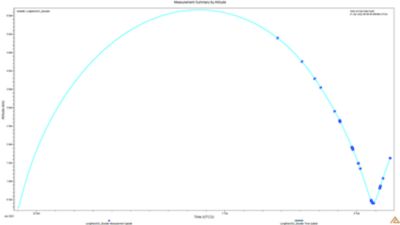
Each blue dot represents a set of telescope observations of the booster.
Several years after launch and a few harmless flybys of the Moon, the orbit became altered. A series of three flybys set up the booster for its eventual demise. These flybys occurred on September 18, 2021; January 5, 2022; and February 5, 2022. Ansys’ orbit determination solution revealed the effect of the flybys on the booster’s semimajor axis and inclination, as depicted in the graph below.
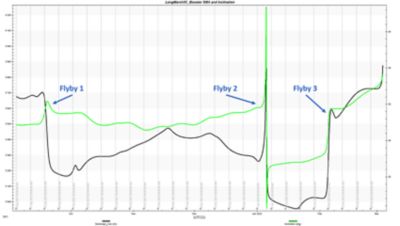
This plot of the booster’s semimajor axis and inclination clearly illustrates how its orbit is affected by each flyby.
The flyby in January was the most important, significantly altering the semimajor axis, eccentricity, and inclination of the booster’s orbit. At its closest approach, the booster passed less than 12,000 km from the Moon’s surface. We calculated that the January flyby imparted an equivalent Delta-V of nearly 640 m/s on the booster. After the third gravity assist on February 5, the booster’s next and final lunar encounter would result in impact with the surface of the Moon.
Initial Orbit Solution
Equipped with measurements collected and published by astronomers around the world, we used ODTK and its optimal sequential filter to process the right ascension and declination measurements and verify Gray’s conclusion that the booster would impact the Moon. This orbit solution included measurements from the beginning of September 2021 through January 20, 2022, and covered two lunar flybys. Plots of the right ascension and declination measurement residuals are shown in the plots below. The residuals represent the difference between where the orbit solution predicted the booster would be and where it was measured to be in optical observations. Good agreement between orbit solution prediction and optical observation was required for confidence in the prediction.

Each point represents an individual measurement, and each color represents an observatory. Note that the majority of the residuals are under an arcsecond in size.
The position uncertainty of our orbit solution, including all tracking measurements up to January 20, are presented in the plot below. While uncertainty was initially high, we gained more confidence in our solution as more observations were collected in 2022 after the January flyby.
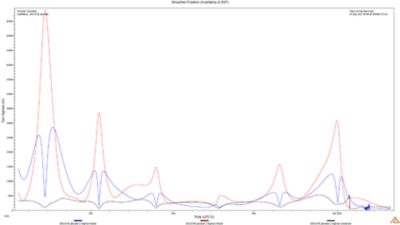
Position uncertainty of our orbit solution using ODTK. Note that uncertainty increases significantly around each flyby date, but it diminishes soon after new observations are recorded and processed.
With this data, we propagated our orbit determination solution to visualize the booster’s covariance ellipsoid in STK. The tumbling of the booster results in a time-varying force caused by solar radiation pressure impinging on the booster’s sunlit side and introduced new complexities for an accurate model of the forces on its body.
Taking all the forces of Earth, the Moon, and the Sun into account, our initial model indicated that the booster would impact the Moon in the vicinity of the large Hertzsprung crater on March 4, 2022, at about 12:27:46 UTC with a speed of 2.6 km/sec. Hertzsprung is located on the far side of the Moon, which means we would not be able to observe the collision from here on Earth. Using STK’s Astrogator capability to propagate our orbital solution and employing a “zero-altitude above topography” stopping condition, we initially predicted that the impact site would be approximately 4.41° N, 131.19° W4.41° N, 131.19° W. However, the story didn’t end there.
Refining Our Solution
Using the results of the initial solution, we increased our confidence in the impact location and timing whenever new tracking data was obtained. From February 5-9, 2022, astronomers observed the booster once again to collect more data. We used this data to restart our filter and produce a refined orbit solution with small uncertainty in the impact conditions. The measurement summary and refined filter residuals and position uncertainty plots are displayed below.
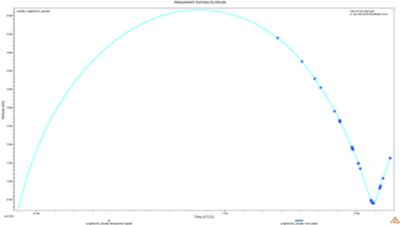

With this newly processed data, we found the booster would impact the Moon at 4.58° N, 129.06° W on March 4, 2022, 12:26:58 UTC. This changed our impact time by about one minute and moved the impact site prediction by just over 250 km closer to the center of Hertzsprung crater. The prediction from our original orbit solution was identical to our new orbit solution up until February 5, 2022, when new tracking data was obtained. At that time, the new solution’s covariance was reduced due to the infusion of measurement information, but the updated position uncertainty ellipsoid is contained in the position uncertainty from the prior solution. This statistical consistency between the initial and refined solutions was necessary for having a realistic covariance for the initial solution and gave us a sense of confidence in the realism of the updated solution and associated uncertainty. Because of the booster’s lighting conditions, optical telescopes would be unable to image the booster again before impact. This means the refined solution would provide our best estimate for where the booster would ultimately land.
What Now?
While we couldn’t see the impact in real time, satellites orbiting the Moon could see the aftermath. In particular, NASA’s Lunar Reconnaissance Orbiter (LRO) and ISRO’s Chandrayaan-2 could pick out the new crater created by the booster’s impact. Both satellites have onboard cameras capable of imaging the predicted crash site.
To predict when these satellites would have their first opportunities to image the site, we loaded ephemeris data into STK and determined when each satellite will next pass over Hertzsprung while lit by the Sun. We used a known ephemeris published by JPL for the LRO, but we had to simulate Chandrayaan-2’s future orbit with Astrogator because limited predictions are available. With a predicted state vector from February 23, 2022, we used Astrogator to propagate the ISRO’s satellite forward, including expected station-keeping.
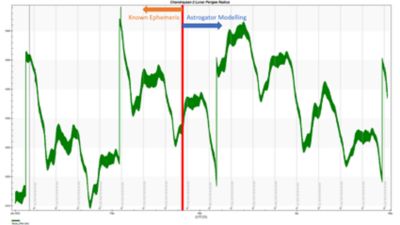
Each sharp increase in perigee radius shows a station-keeping burn required to keep Chandrayaan-2 in its nominal orbit, about 100 km above the surface of the Moon.
With these orbits, we expected that the LRO’s first post-impact pass over the sunlit Hertzsprung crater would occur March 28, 2022, and Chandrayaan-2’s first pass would come shortly after on April 4, 2022. Pending instrument availability and a little bit of luck, we could catch a glimpse of the booster’s remnants. Additionally, the impact crater is likely to expose some fresh lunar crust for imaging by these satellites, and the resulting data may have scientific value for geologists researching the Moon. Using STK’s Electro-Optical Infrared (EOIR) capability, we could model the LRO’s wide-angle camera with publicly available technical specifications and create a rendering of what it might see on its pass at the end of March.
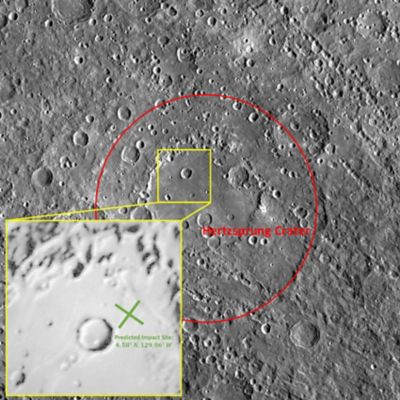
Background image shows previous composite observations taken by the LRO’s NACs, and inset shows an EOIR-simulated WAC view of the impact site as the LRO passes overhead.
The impact posed no threat to missions operating on the lunar surface, including historical Apollo landing sites and other lunar probe locations. However, as humanity looks to make greater use of cislunar space in its bid to return to the Moon, the global community needs to be more cognizant of tracking debris and properly disposing of it when possible. Without the hard work of amateur astronomers keeping an eye on this booster, it is likely that its collision with the Moon would have gone completely unnoticed. Cislunar space introduces a host of complex multibody physics, and we can take advantage of this to develop novel trajectories and provide precise orbit determination solutions. Ansys is a pioneer in providing simulation tools that can be leveraged to fit this need — plus so much more.
Learn more about how Ansys STK and Ansys ODTK can help your orbit determination and lunar missions at our missions page.